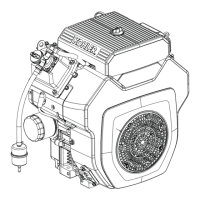5. Carefully remove main jet(s) from carburetor. For
two-barrel carburetors, note and mark jets by
location for proper reassembly. Main jet(s) may be
size/side specifi c. After main jets are removed, on
some carburetors, main nozzles can be removed
through bottom of main towers. Note orientation/
direction of nozzles.
For two-barrel carburetor, end with 2 raised
shoulders should be out/down adjacent to main jets.
Save parts for cleaning and reuse.
6. Position of slow jet varies and is removable only on
some styles of carburetors. See correct illustration
for corresponding style of carburetor showing
location. (On two-barrel carburetors, slow jets may
be sized to specifi c side. Mark or tag jets for proper
reassembly. Note small O-ring on bottom of each
jet.) Save parts for cleaning and reuse unless a jet
kit is also being installed. Clean slow jets using
compressed air. Do not use wire or carburetor
cleaner.
7. Remove idle speed (RPM) adjustment screw and
spring from carburetor. Discard parts.
Carburetor is now disassembled for appropriate
cleaning and installation of parts in overhaul kit.
Further disassembly is not necessary. Throttle shaft
assembly, fuel inlet seat, idle fuel adjustment screws
with limiter, and carburetor body, are non-serviceable
items and should not be removed. Choke shaft
assembly is serviceable, however it should not be
removed unless a choke repair kit will be installed.
To install choke repair kit go to step 8, otherwise go
to step 18.
8. Remove and discard plastic cap from end of choke
lever/shaft assembly.
9. Note position of spring legs and choke plate for
correct reassembly later. Remove screws attaching
choke plate to choke shaft. Pull shaft out of
carburetor body and discard removed parts.
10. Use a screw extractor (easy-out) and remove
original choke shaft bushing with old choke lever
from carburetor housing. Save bushing to use as a
driver for installing new bushing. Discard old lever.
11. Clean I.D. of both choke shaft bores as required.
12. Insert new bushing through new choke lever from
outside and start bushing in outer shaft bore.
Position choke lever so protruding boss on
carburetor housing is between 2 stops formed in
choke lever.
13. Turn old bushing upside down and use it as a driver
to carefully press or tap new bushing into carburetor
body until it bottoms. Check that choke lever pivots
freely without restriction or binding.
14. Install new return spring onto new choke shaft, so
outboard leg of spring is behind formed stop on end
of choke shaft for two-barrel carburetor or between
two formed stops on end of choke shaft on one-
barrel carburetor.
Make sure it stays in this location during following
step.
15. Slide choke shaft and spring into carburetor. Pivot
(preload) shaft 3/4 turn counterclockwise with inner
leg of spring against formed stop within choke lever
as originally assembled. Outer leg of spring must still
be in same position as step 14.
16. Place a drop of Loctite
®
222MS™ on threads of each
new screw. Position and install new choke plate to
fl at side of choke shaft. Start screws. Larger cutout
must be on right. Close choke and check plate
alignment within carburetor throat, then tighten
screws securely. Do not overtighten.
17. Check for proper operation and free movement of
parts. Install new cap.
18. Clean carburetor body, main jets, vent ports, seats,
etc., using a good commercially available carburetor
solvent. Keep away from plastic or rubber parts if
non-compatible. Use clean, dry compressed air to
blow out internal channels and ports. Do not use
metal tools or wire to clean orifi ces and jets. Inspect
and thoroughly check carburetor for cracks, wear, or
damage. Inspect fuel inlet seat for wear or damage.
Check spring loaded choke plate to make sure it
moves freely on shaft.
19. Install main nozzle(s) into tower(s) of carburetor
body. End of main nozzle(s) with 2 raised shoulders
(if equipped) should be out/down (adjacent to main
jet(s)). Make sure nozzle(s) are completely
bottomed. Carefully install main jet(s) into tower(s) of
carburetor body on appropriate side, as identifi ed
when removal was performed.
20. For two-barrel carburetor, make sure O-ring near
bottom of each slow jet is new, or in good condition.
Align and insert slow jets into top of carburetor.
For one-barrel carburetor, install slow jet and new
plug into end of slow jet tube.
21. Install large fl at retaining washer (if equipped) and
secure with mounting screw, attaching ground lead if
originally secured by screw.
22. Install new idle speed (RPM) adjustment screw and
spring onto carburetor. Thread in until 3 or 4 threads
are exposed, as an initial adjustment.
23. Attach inlet needle to plastic tang of fl oat with wire
clip. Formed 90° lip should point up, with needle
valve hanging down.
24. Install fl oat and inlet needle down into seat and
carburetor body. Install new pivot pin through fl oat
hinge and secure with new retaining screw.
25. Hold carburetor body so fl oat assembly hangs
vertically and rests lightly against fuel inlet needle.
Inlet needle should be fully seated but center pin of
needle (on retainer clip end) should not be
depressed. Check fl oat height adjustment.
Be sure to measure from casting surface, not rubber
gasket, if still attached.
Fuel System
30 24 690 06 Rev. PKohlerEngines.com

